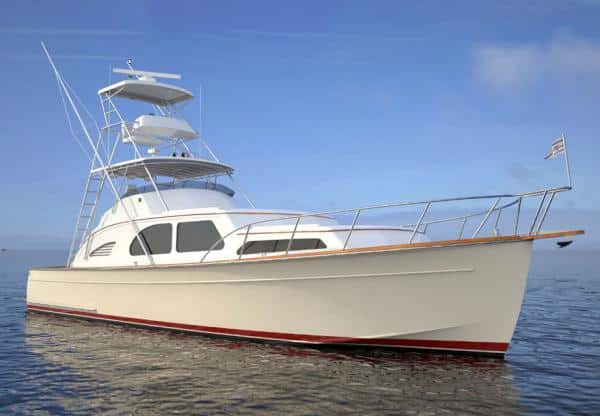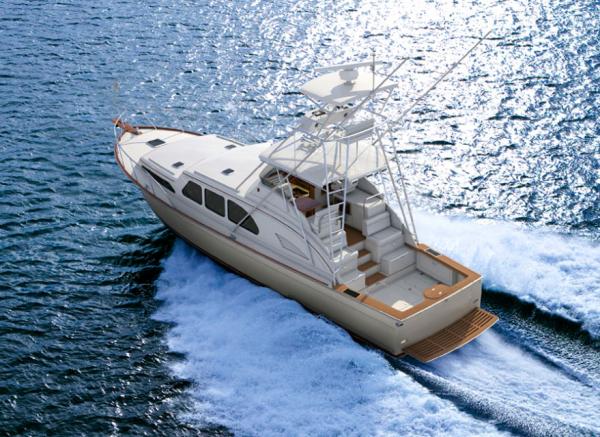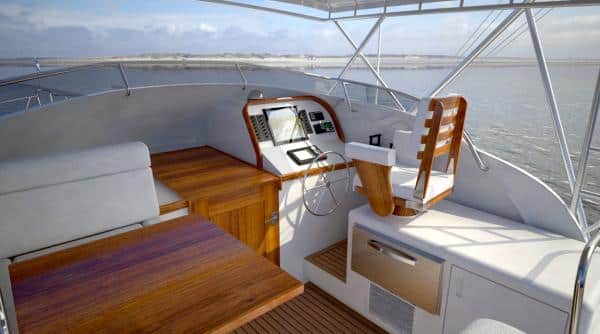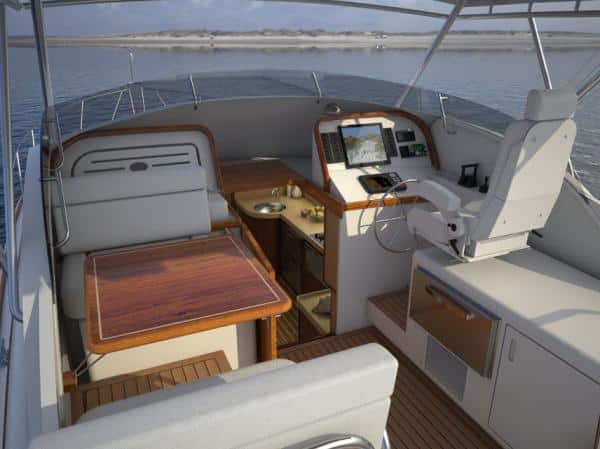
Spare is one way to describe the styling of Huckins‘ 45 Sportfisherman (45 SF). That’s a good thing, because any attempts to dress the exterior with eye-catching gimmicks would ruin her looks for sure. Although the 45 SF doesn’t show us any obvious automotive themes, her clean lines and harmonious blend of shapes remind me of the Ferrari 166 MM Barchetta, last built in 1953. The car is elegant and purposeful beyond imagining, as is this Huckins.
Huckins derived the 45 SF from its Sportsman 44. Introduced late in 1996, the 44 is a modern interpretation of the Sportsman 40, originally designed in 1946 and built of wood in series into the 1960s. Although the 44 bears a striking resemblance to the 40, modifying the design for production in fiberglass allowed the company to soften the edges of the superstructure. From this base, Huckins and Bill Prince Yacht Design have now combined the needs of serious anglers with the grace and classic style of a midsize cruising yacht. This makes the Huckins 45 Sportfisherman one of the top fishing yachts on the market.

The historical drawings and photos available in the book Huckins: The Living Legacy show that the early Sportsman and her sport-fishing offspring had a nearly straight sheer line — a very businesslike look — but the current 44 and her 45 SF sibling enjoy the grace of a springier sheer, enhanced by a sweetly curved stem and a trace of tumblehome at the transom. Substantial bow flare adds a bit of drama to the look and helps to keep green water off the decks when the seas get nasty.

The superstructure, like that of the Sportsman 44, spans a large percentage of the boat’s overall length, allowing the interior to have all the headroom it needs for comfortable habitation forward of the salon, as well as in it. This length also decreases our perception of the yacht’s height. More important to the aesthetics of the 45 SF, though, is the way the rake of the trunk cabin’s front fascia and that of the main deckhouse visually lower the superstructure’s profile. The three tiers — trunk cabin, deckhouse and flying bridge — give the yacht a sculpted appearance. Identical degrees of rake at the front of the flying bridge and in the design of the tower keep this relatively tall structure from dominating the overall design.
Big windows on each side of the main deckhouse flood the salon with gobs of light and visually further lower the profile. I like the way these windows, seen as a unit, mimic the overall shape of the house. The fastback terminus of the deckhouse and flying bridge, accented by the teak eyebrow along the side of the house, brings the design to its logical conclusion. What happens visually after that is irrelevant.

Honest styling, sound engineering and creative naval architecture have characterized Huckins’ yachts since Frank Pembroke Huckins drew the first Fairform Flyer late in the 1920s. Although the styling has varied greatly among the models during the years since, every Huckins rides on a variation of the original Quadraconic hull, the company’s name for its warped-plane V-shaped bottom. Enthusiasts of this hull form will be happy to hear that Prince left it intact, save for adding 5 inches to the length and modifying the bottom near the transom to accept Zeus pod drives. This is a wonderfully economical and seakindly hull and is a large part of any Huckins’ appeal.
Specifications:
LOA: 45’5″
Beam: 13’9″
Draft 3’0″
DispL.: 27,000 lb.
Fuel: 419 gal.
Water: 115 gal.
Engines: 2 x 425 hp Cummins QSB 7.7 diesels
Speed: 30+ knots
Huckins Yacht Corp., 904-389-1125; huckinsyacht.com









